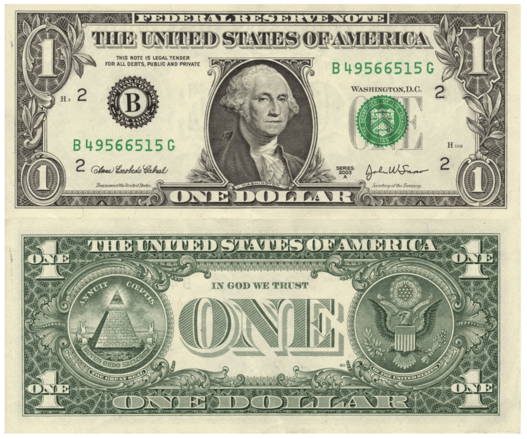Discover 3 powerful leadership secrets hiding in plain sight.
4-minute read
Some of my greatest work/life lessons have come from unusual places. I’ve learned the value of a strong opening offer from my dog Buster who used to begin our sleeping arrangement negotiations by jumping full-body on my bed. I’ve learned the significance of finding balance in life from tuning my bass: too much and the string snaps, too little and it makes no sound. I’ve learned the importance of setting small yet challenging goals as I watched my two sons stumbling into my arms while learning to walk.
To this list, I will add leadership lessons I found in my wallet, in particular from the one-dollar bill.

1) Be flexible.
Dollar: The eagle on The Great Seal is one of the most iconic symbols of the United States. It symbolizes both the spirit and practical wisdom of the Founding Fathers. In its right talon, the eagle grasps an olive branch made of thirteen leaves, signifying peace. In its left talon, there are thirteen arrows representing war. The face of the eagle is oriented toward peace. That is to say: we choose peace before war, cooperation before competition. But if this approach isn’t reciprocated, we are also very capable of getting tough.
Leadership: The beauty of this symbol is that it warns us not to get fixated on one strategy. It reminds us to develop skills outside our default orientation and flex to fit the situation. So if one approach does not work, we have to pivot to try another one. Research shows that individuals who keep their strategies and tactics flexible report greater satisfaction with productivity, relationships, conflict, feedback, and innovation. They also report less stress and fewer intentions to quit their jobs.
Call to action: Next time you face a familiar problem, ask yourself, “What is a different solution I might try?”
2) Unite through purpose.
Dollar: On the other side of the Great Seal is the (unfinished) pyramid with steps leading to the Eye of Providence. Religious significance aside, the symbol speaks to the importance of linking tasks to a shared purpose (“E pluribus unum” meaning "Out of Many, One"). The fact that the pyramid is unfinished speaks to the notion that as a nation we are always evolving but never fully evolved.
Leadership: On an individual level, purpose creates motivation and grit. With it, even mundane tasks can become extraordinary. To quote Nietzsche, “He who has a why, can bear almost any how.” Research shows that connecting employees’ work to concepts that matter to them increases engagement, satisfaction, and productivity.
As we've found at LifeLabs by studying what great managers do differently, having a shared purpose also provides clarity and cohesion. It’s the glue that holds a team together. Articulating collective purpose is especially useful when managing diverse teams (unity allows us to leverage different perspectives).
Call to action: Ask your team, “What matters to you most about the work our team does?”
3) Say it again.
Dollar: The one dollar bill is chock-full of symbolism, on repeat. Take the number 13 (standing in for the 13 United States) its permutation appears as arrows, leaves, olives, stars, steps, bars (on the shield) and as phrases (both “annuit coeptis” and “e pluribus unum” have 13 letters). Likewise the number 1, appears 11 times on the bill.
Leadership: Scholars debate how often someone needs to hear and see a message before they internalize it. Some argue the threshold is 3, or 7, or 20 times. While there is no one right answer (much depends on the situation), the consensus is that people need to be exposed to a message multiple times before it sticks. And the more you hear it, the more you believe it (see the mere-exposure effect).
Call to action: Ask yourself, “Do I repeat our team mission and goals enough?” If not, decide on one way to share your message this week.
So there you have it - from flexibility, to purpose, to effective repetition - becoming a leader should not cost an arm and a leg. In fact, just a dollar should do it.





